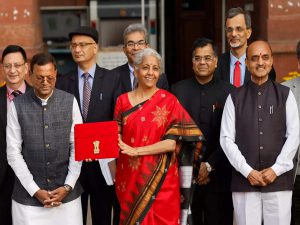The Gujarat government amended its APMC Act of 1963 in line with the Centre’s Farmers’ Produce Trade and Commerce (Promotion & Facilitation) Ordinance nearly a month before the latter’s promulgation on June 5.
Mombhai Japda watches labourers weighing his 50 quintals of groundnut under a giant shed at the APMC (agricultural produce market committee) yard in Gondal. The four-acre farmer from Lakhtar village of Jamnagar district’s Jodiya taluka has carted his entire produce, harvested last November, to sell at the Gondal APMC near Rajkot more than 100 km away.
“Why wouldn’t I, when the prices here are better even after accounting for transport cost of Rs 100 per quintal?,” asks the 32-year-old, who has realised a rate of Rs 5,925 per quintal. That is more than the government’s minimum support price (MSP) of Rs 5,090, although Japda has sold after storing his crop for over seven months.
“The government would have procured only half of my produce at the MSP. And the price I have got is higher than even at the Hapa APMC near Jamnagar, just 38 km from my village,” he adds.
Japda is among those in Gujarat’s Saurashtra region – a major cotton and groundnut bowl – not particularly impressed by the Narendra Modi government’s recent reform allowing farmers to sell their crops directly to oil millers, ginners, traders or exporters without having to bring to APMC mandis. Such sales outside the physical boundaries of APMC market yards will also not attract any fees levied by these government-regulated bodies.
Japda’s view is echoed by Dhana Parmar, who farms 8 acres at Lunagara village in Rajkot district’s Jetpur taluka. “The oil millers who will come to buy from our farmgate are likely to tamper with the weighing scales. There is no such cheating at the APMC,” he says.
Ravji Rupareliya, a 14-acre farmer from Kolithad village of Gondal taluka, cites a different reason why he prefers APMCs. “I have tried selling directly. But traders visit villages only during the harvesting season, when significant quantities are offered by many farmers, making it viable to bring vehicles and labourers. In the APMC, one can sell any day even in the off-season at the going rate and return home with money in hand,” notes the 69-year-old, who has just sold 18 quintals of dhaniya (coriander seeds) fetching Rs 1.04 lakh.
Rasik Bhuva, who cultivates 3 acres at Lunagara, is more hopeful. “I sell my cotton directly to some ginners. They usually offer prices lower than at the APMC, but I save on loading, unloading and transport costs. If the new law will enable more buyers to turn up at my farm, that would be good. Farmers can earn profits only if they are in a position to bargain better and fix the price of their produce,” points out Bhuva, who has sold his 36 quintals of wheat at Rs 1,650 per quintal (below the MSP of Rs 1,925) to a local trader.
The Gujarat government, incidentally, had amended its APMC Act of 1963 in line with the Centre’s Farmers’ Produce Trade and Commerce (Promotion & Facilitation) Ordinance nearly a month before the latter’s promulgation on June 5.
Spread over 77.5 acres, the Gondal APMC is India’s biggest wholesale market for groundnut. With 15 auction sheds, 48 godowns, 500 traders’ shops-cum-offices and three bank branches, it also trades in red chilli, garlic, coriander and sesame seeds. “The new amendments/law isn’t going to affect us much. The reason why farmers from across Saurashtra bring their produce here is because of price discovery through open auctions involving many buyers, proper weighment and cash payment on the spot,” claims Gopal Shingala, chairman of the APMC that handles annual transactions of around Rs 2,000 crore.
He, however, concedes that the APMC might lose some revenues from the average 0.6% cess it charges on every sale that takes place on its yard as well as in 81 villages of Gondal taluka. The latter, too, fell under its jurisdiction before the Gujarat government’s May 6 amendments.
Gujarat has 224 APMCs. Till the amendment to the state’s APMC Act, all of them exercised powers to levy fees on produce transactions even beyond their market yard boundaries. Any trader buying produce from a market yard or even directly from farmers in villages falling under its jurisdiction had to obtain a license from the APMC concerned. He had to procure similar licenses to purchase from other APMC areas as well. But the amended law has declared the whole of Gujarat as a single market, making the license issued by any APMC valid for the entire state. Further, any warehouse, silo or cold storage facility can be converted into a market sub-yard, with APMCs having no powers to levy any fee on transactions undertaken there.
Dinesh Patel, chairman of the APMC at Unjha in northern Gujarat’s Mehsana district, isn’t convinced about the recent reforms or even the idea of establishing independent private markets for farm produce. “What purpose do they serve? Just increasing the number of markets makes no sense unless the number of traders also goes up. Besides, most farmers are marginal cultivators. How many of them can approach traders directly?,” he quips. Unjha APMC, which is the world’s biggest wholesale market for jeera (cumin seed), collects annual cess revenues of about Rs 30 crore, Out of that, Rs 12 crore is from transactions outside its main market yard.
Manish Bhardwaj, secretary at the Gujarat government’s department of agriculture & cooperation, emphasises that the reforms do not seek to shut down APMCs, but limit their regulatory powers to trading within their market yard boundaries. “Nothing stops them from setting up more such yards in order to reach the maximum number of farmers. The bigger APMCs such as Gondal, Unjha, Rajkot and Surat should even take up processing and value addition businesses, in addition to just facilitating trades,” he tells The Indian Express.
Out of the estimated Rs 1.4 lakh crore of annual trading under the jurisdiction of APMCs in Gujarat, only about Rs 35,000 crore actually takes place within the physical boundaries of their market yards.
The ones least enthusiastic about the current reforms are the licensed APMC commission agents, who act as the link between farmers and the traders and charge a 1.5% fee on the value of every transaction “facilitated” by them.
“We are the safety net for farmers. We not only arrange for the auctioning of farmers’ produce, but also pay them immediately on the traders’ behalf. We receive payment from traders only after 3-7 days, which means the risk of default is borne entirely by us. If traders start purchasing directly from farmers, who will guarantee payments?,” states Mukesh Satasiya, president of Gondal APMC Commission Agents Association.
Bharat Gondaliya, a groundnut trader, does not see business moving out of the established APMCs. “The smaller ones may not survive, but I don’t see myself going from farm to farm to buy produce. In APMCs like Gondal, I can get enough volume of the required quality at a single place almost round the year. That’s precisely the advantage offered by a mandi,” he sums up.




